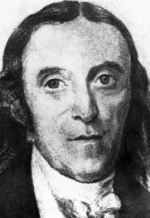Johann Schweigger facts for kids
Quick facts for kids
Johann Schweigger
|
|
|---|---|
 |
|
| Born |
Johann Salomo Christoph Schweigger
8 April 1779 Erlangen, Brandenburg-Bayreuth
|
| Died | 6 September 1857 (aged 78) Halle, Prussian Saxony
|
| Alma mater | University of Erlangen-Nuremberg |
| Known for | First galvanometer |
| Scientific career | |
| Fields | Physics, chemistry, mathematics |
| Institutions | Bayreuth Gymnasium University of Erlangen-Nuremberg University of Halle-Wittenberg |
| Academic advisors | Georg Friedrich Hildebrandt Karl Christian von Langsdorf Johann Tobias Mayer |
| Doctoral students | Wilhelm Eduard Weber |
| Other notable students | Franz Wilhelm Schweigger-Seidel |
Johann Salomo Christoph Schweigger (born April 8, 1779 – died September 6, 1857) was a smart German scientist. He was a chemist, a physicist, and a professor of mathematics. He was born in a town called Erlangen.
Contents
Early Life and Studies
Johann Schweigger's father was a professor of theology in Erlangen. Johann first studied philosophy at the University of Erlangen. However, his teachers, Johann Tobias Mayer, Georg Friedrich Hildebrandt, and Karl Christian von Langsdorf, encouraged him to study physics and chemistry instead.
He taught these subjects in Erlangen until 1803. After that, he worked as a schoolteacher. He taught in Bayreuth and then in Nuremberg starting in 1811. From 1816 to 1819, he became a professor of philosophy back in Erlangen. There, he taught physics and chemistry. In 1816, he was chosen to be a member of the Academy of Sciences Leopoldina, a famous science academy. In 1819, he moved to the university in Halle.
Inventing the Galvanometer
In 1820, Johann Schweigger created a very important tool. He built the first sensitive galvanometer. He named it after Luigi Galvani, another famous scientist.
What is a Galvanometer?
A galvanometer is a device that can find and measure small amounts of electric current. Schweigger made his by wrapping a coil of wire around a compass. This made the compass needle move when electricity flowed through the wire. This movement showed how much electricity was present. His invention was first called a "multiplier" because it made small currents easier to see.
Family Life
Johann Schweigger was the father of Karl Ernst Theodor Schweigger. He also adopted one of his students, Franz Wilhelm Schweigger-Seidel, as his own son.
Written Works
Johann Schweigger wrote several books and papers about his ideas. Here are some of them:
- Einleitung in die Mythologie auf dem Standpunkte der Naturwissenschaft, Halle (1836) – This book was an introduction to mythology. It looked at old stories from a science point of view.
- Über naturwissenschaftliche Mysterien in ihrem Verhältnis zur Litteratur des Altertums, Halle (1843) – This work explored scientific mysteries. It connected them to old writings and literature.
- Über das Elektron der Alten, Greifswald (1848) – This book was about the idea of the electron in ancient times.
- Über die stöchiometrischen Reihen, Halle (1853) – This paper discussed stoichiometry series. Stoichiometry is about measuring elements in chemical reactions.
See also
 In Spanish: Johann Schweigger para niños
In Spanish: Johann Schweigger para niños

